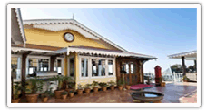|
|
|
| |
| |
Travel destination in India, Chandigarh |
|
|
| |
General Information about CHANDIGARH |
Chandigarh :
Area : 114sq.km
Language : Hindi, Punjabi and English
Altitude : 365.76 meters
State : Haryana and Punjab
STD Code : 0172 |
About Chandigarh
Chandigarh is the 1st planned modern city of India designed by the French architect Le Corbusier. Chandigarh and the area surrounding it were constituted as a union territory on 1st November, 1966. It serves as the joint capital of both, Punjab and Haryana states. It is bounded on the north and west by Punjab and east and south by Haryana. Total area of the union territory is 114Sq.Km.
The city was named after the mother goddess of power, Chandi, whose temple Chandimandu is a feature of the new city. Le-Corbusier was assisted by his cousin, Pieree Jeanneret and the English couple E.Mazwell Fry and Jane B. Druel. These 3 architects are responsible for most of the public and residential building raised in Chandigarh between 1950 and 1965. The beautiful city also known as 'city of roses', was planned to house the capital to the erstwhile Punjab state. On partition of Punjab, on linguistic basis, the present union territory was formed which in addition to the city of Chandigarh included Mani Majra town and some villages of Kharar Tehsil of Ambala district.
CLIMATE
The summers in Chandigarh city are really hot with murcury shooting up to 46o C. Wear light and cottons for comfortable travelling during this season. To save yourself from sunburns if you have to be out for long duration you must wear full sleeves and cover your all body parts. The monsoon in Chandigarh city is from June to September. The Monsoon in Chandigarh brings some delicious cool days and some of sweltering steamy ones. Summery clothes hold good for this season -- and synthetics that dry quickly -- but don't expect good leather shoes to last long. Put on your all-weather footwear. The total average rainfall in Chandigarh is 1.01 meters with most of it in Monsoon season only.
PLACES OF ATTRACTION IN CHANDIGARH
• ROCK GARDEN: Chandigarh has the distinction of having world acclaimed Rock Garden. It consists of art objects made from industrial and urban waste. It is the first one of its kind in the World.
• SUKHNA LAKE: Sukna lake an artificial, manmade lake spread over 3 square kilometers on the northern border of Chandigarh is the venue of the Asian rowing championships. The tree-shaded shores is a favorite spot for strolling and bird watching. From December through February, one can see many species of aquatic birds from Central Asia and Siberia. Sukhna lake has facility for renting rowing boats and there is also a children's park.
•International Dolls Museum:This museum situated in Bal Bhawan in Sector 23, contains more than 300 dolls from nearly every country in the world. It was inaugurated on 24th December, 1985. Visiting Hours : 09.00 a.m. to 05.00 p.m. all days except official holidays.
•Rose garden: The largest Rose Garden in Asia, it is spread over an area of 27 acres and has more than 17,000 plants representing some 1,600 varieties of roses as well as several fountains.
• The High Court: The High Court is a classic work of modern architecture. It is one of the first monuments to be built in the Capital complex. The structure of this building has a double roof, projecting over the office block, like a inverted umbrella shading its lower part, symbolizing the law as an umbrella of shelter for the ordinary citizen.
• The Open Hand Monument: Open Hand monument in the Capital Complex in sector 1, is made of a metal sheet, 14 metres high and weighing 50 tonnes and rotate freely in the wind from a high concrete pedestal. Some times it resembles a bird in flight The design of this giant hand emblem was conceived by Le Corbusier. The symbol stands for peace and unity - 'Open to give - Open to receive'. It is official emblem of the city.
|
|
|
| |
|
|
|







